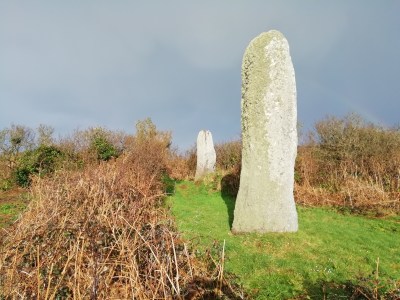Druids have no shrines except nature. We honour all life and beings on our earth
and eek wisdom from myth and honour our ancestors. Traditionally druids profess
their learned wisdom in ritual in ancient groves. Their presence remains enigmatic,
though it endures through the ages. In the course of my path, there are certain sites where their voices resonate. I am of Ireland and her ancient places seep into my bones and osmose from my being, but I also sense that same primal peace in Brittany in France.

Brittany is the finger of land that juts out into the westernmost part of the
stretched cowhide that is France, the inland boundaries of which are the river Siene and the River Loire. I am in Finistère in the Pays d’Iroise region close to the Pointe de Corsen, the westernmost point of continental France. Druids have always had an essential place in Breton society and to this day officiate at sites considered sacred to that tradition.

Finistère derives from the Latin Finis Terræ, meaning end of the earth. It is a
sort of megalithic heaven, and I am of the school that believes it is from these places that nature transmits her power. I can see why the ancestors believed this to be the end of the earth, it is a liminal place betwixt rich ochre earth and sage green sea. The menhirs of Traonigou are a delightful hidden gem close to the hamlet of the same name. Hidden seems a misnomer for this alignment of standing stones, as the taller stone scales to over four meters, however, they do get covered in ferns in the summer, so this seems apt somehow. It comprises of 4 menhirs, two of which have fallen, leaving two remaining upright and is supposedly aligned on the mid-
summer sunrise.

The two surviving menhirs are of pink granite. The westernmost is 4.15 m
high, 1.30 m wide and 1 m thick at the base. The easternmost is 2.95 m high and
1.15 m wide. They are thought to date from the neolithic between 5000 and 2000
BC. That two remain upright is quite something. The eastern monolith has been
Christianisation and sports a cross engraved near the top. This is not an unusual
feature in Breton megaliths.

In general, there are more megaliths intact in the maritime regions than in
those inland. Whilst farming accounts for some of their destruction, religious
fundamentalism is the other culprit responsible for the destruction of these timeless monuments. The practice of Christianisation of such sites, however, where they became carved with Calvary crosses, symbols of the passion etc in fact helped to preserve them.

Ourzal a 6 th century ‘Celtic’ evangelist is much associated with the site.
Imbued with special powers he brought with him a blessing for every age of man. A nearby sacred well cured lameness in children when immersed in it three times,
while circling his church clockwise thrice guaranteed a good harvest. Women came to him to appeal for a husband, while young men sought a wife. Sailors too relied on him to be brought home safely and swiftly from the treacherous waters off the coast. Not much is known about these menhirs that we see them today, but it is certain is that they had a very important function in the eyes of their builders. These monuments of stone were not hewn nor erected easily, they took toil and effort and an inner conviction, placed as they were on the western shore at the edges of eschaton.

The landscape of this alignment lends itself to fantasy and wonder with
large granite outcrops everywhere, forming mystical shapes. Alongside of this there are many other prehistoric monuments, dolmens, Iron age steles and Roman
remains. I visited Traonigou one morning close to the vernal equinox when the ferns were russet and low to ground. There was nothing hidden about them, in fact, they were impossible to miss. I was conquered by their majesty, captivated even, as much by their immensity as by their mystique. I felt at once the missing menhirs, but was placated by a sense of it being as it should be. It is wild in this place with an ever-changing aspect, whatever the weather.

This end of the world place with its powerful wind loaded iodized mist reminds
me that the might of nature is ever present. In my mind I heard the rumble of eons of history but as I stood in the grace of the sunshine of a shower laden day all seemed right. These granite columns cast their shadows eastward and I witnessed only peace. The honour of being in the presence of such stalwart sentries is indescribable. I paid homage in my druid way, asked them to endure for another few millennia, knowing that to be their gift. I left them as I found, leaving no trace.
GPS : 48° 29′ 29.7 N 4° 45′ 27.5 W

